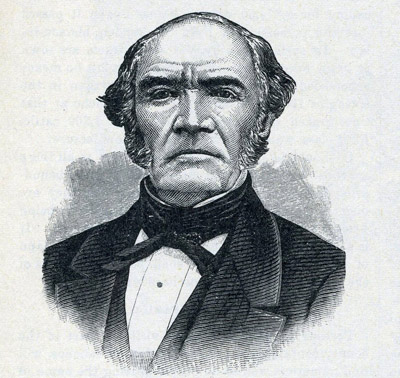Who Was Benjamin Foxen?
The Englishman Moved to S.B. in the 1830s and Became Successful Rancher

William Benjamin Foxen was born in England in 1796. He arrived in Santa Barbara in the mid-1820s as a merchant seaman and became a prosperous rancher. He is best known in local lore for an incident during the U.S.-Mexican war of the 1840s, an incident that actually never took place.
When he arrived here, Foxen opened trade negotiations with Tomás Olivera, owner of the site of today’s San Ysidro Ranch, who introduced Foxen to his stepdaughter, Eduarda Osuna, a young woman with whom Foxen was most taken.
For a number of years, Foxen traveled up and down the coast, stopping here periodically. José de la Guerra and two business associates eventually hired Foxen to build a ship for them, near an estuary that fed into the Goleta Slough. The successful launch of the ship solidified the relationship between Foxen and one of the most influential figures in Alta California.
In 1831, after his conversion to Catholicism, Foxen and Eduarda Osuna were married at Mission Santa Barbara. Six years later, he purchased Rancho Tinaquaic, located northeast of present-day Los Alamos. He moved his growing family, which ultimately would include 12 children, to the ranch and built an adobe home in what is now called Foxen Canyon. During construction, the family slept on the roof of the partially finished house to avoid the nocturnal wanderings of bears, still plentiful on the South Coast.
War broke out between the United States and Mexico in 1846. In December, John C. Fremont was heading south with a small force toward Santa Barbara to secure the pueblo for the U.S. Word came to Foxen that Santa Barbarans were moving to ambush Fremont in the narrow, twisting defile of Gaviota Pass. Foxen convinced Fremont to bypass Gaviota, move through the Santa Ynez Valley, and take San Marcos Pass down to Santa Barbara, thus saving the Americans from possible disaster and allowing them to take the town unopposed.
Good story, but it never happened, as historian Walker Tompkins showed. He posited that Fremont had most probably decided on the San Marcos route before meeting Foxen, primarily to acquire new mounts in the Santa Ynez Valley. None of the firsthand accounts of Fremont’s campaign mention Foxen and the ambush, which raises suspicions. Tompkins further pointed out that the Santa Barbara forces had moved to Los Angeles to reinforce Mexican troops there.
Nonetheless, Foxen’s sympathies were with the Americans, which caused some resentment on the part of those whose loyalty lay with Mexico. Some of Foxen’s livestock were slaughtered and the family home was torched. Foxen, however, persevered and eventually built a very successful horse-breeding operation. San Francisco bought a number of his horses to pull its streetcars. Foxen’s home became a stagecoach stop, and he reportedly kept a chained grizzly bear to entertain the passengers.
Benjamin Foxen died in 1874 from an infected spider bite. He is buried in the cemetery of the Chapel of San Ramon in Foxen Canyon, erected in 1875 by María de la Soledad Ramona Foxen de Wickenden in her father’s memory. A plaque in Gaviota Pass still memorializes the “rescue” of Fremont by Benjamin Foxen.



